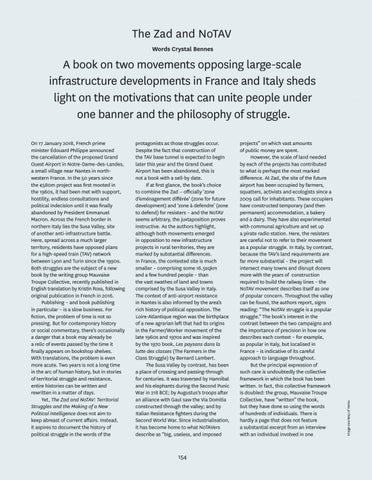The Zad and NoTAV Words Crystal Bennes
On 1 January 2018, French prime minister Édouard Philippe announced the cancellation of the proposed Grand Ouest Airport in Notre-Dame-des-Landes, a small village near Nantes in northwestern France. In the 50 years since the €580m project was first mooted in the 1960s, it had been met with support, hostility, endless consultations and political indecision until it was finally abandoned by President Emmanuel Macron. Across the French border in northern Italy lies the Susa Valley, site of another anti-infrastructure battle. Here, spread across a much larger territory, residents have opposed plans for a high-speed train (TAV) network between Lyon and Turin since the 1990s. Both struggles are the subject of a new book by the writing group Mauvaise Troupe Collective, recently published in English translation by Kristin Ross, following original publication in French in 2016. Publishing – and book publishing in particular – is a slow business. For fiction, the problem of time is not so pressing. But for contemporary history or social commentary, there’s occasionally a danger that a book may already be a relic of events passed by the time it finally appears on bookshop shelves. With translations, the problem is even more acute. Two years is not a long time in the arc of human history, but in stories of territorial struggle and resistance, entire histories can be written and rewritten in a matter of days. Yet, The Zad and NoTAV: Territorial Struggles and the Making of a New Political Intelligence does not aim to keep abreast of current affairs. Instead, it aspires to document the history of political struggle in the words of the
protagonists as those struggles occur. Despite the fact that construction of the TAV base tunnel is expected to begin later this year and the Grand Ouest Airport has been abandoned, this is not a book with a sell-by date. If at first glance, the book’s choice to combine the Zad – officially ‘zone d’eménagement différée’ (zone for future development) and ‘zone à defendre’ (zone to defend) for resisters – and the NoTAV seems arbitrary, the juxtaposition proves instructive. As the authors highlight, although both movements emerged in opposition to new infrastructure projects in rural territories, they are marked by substantial differences. In France, the contested site is much smaller – comprising some 16.5sqkm and a few hundred people – than the vast swathes of land and towns comprised by the Susa Valley in Italy. The context of anti-airport resistance in Nantes is also informed by the area’s rich history of political opposition. The Loire-Atlantique region was the birthplace of a new agrarian left that had its origins in the Farmer/Worker movement of the late 1960s and 190s and was inspired by the 190 book, Les paysans dans la lutte des classes (The Farmers in the Class Struggle) by Bernard Lambert. The Susa Valley by contrast, has been a place of crossing and passing-through for centuries. It was traversed by Hannibal and his elephants during the Second Punic War in 218 BCE; by Augustus’s troops after an alliance with Gaul saw the Via Domitia constructed through the valley; and by Italian Resistance fighters during the Second World War. Since industrialisation, it has become home to what NoTAVers describe as “big, useless, and imposed
154
projects” on which vast amounts of public money are spent. However, the scale of land needed by each of the projects has contributed to what is perhaps the most marked difference. At Zad, the site of the future airport has been occupied by farmers, squatters, activists and ecologists since a 2009 call for inhabitants. These occupiers have constructed temporary (and then permanent) accommodation, a bakery and a dairy. They have also experimented with communal agriculture and set up a pirate radio station. Here, the resisters are careful not to refer to their movement as a popular struggle. In Italy, by contrast, because the TAV’s land requirements are far more substantial – the project will intersect many towns and disrupt dozens more with the years of construction required to build the railway lines – the NoTAV movement describes itself as one of popular concern. Throughout the valley can be found, the authors report, signs reading: “The NoTAV struggle is a popular struggle.” The book’s interest in the contrast between the two campaigns and the importance of precision in how one describes each context – for example, as popular in Italy, but localised in France – is indicative of its careful approach to language throughout. But the principal expression of such care is undoubtedly the collective framework in which the book has been written. In fact, this collective framework is doubled: the group, Mauvaise Troupe Collective, have “written” the book, but they have done so using the words of hundreds of individuals. There is hardly a page that does not feature a substantial excerpt from an interview with an individual involved in one
Image courtesy of Verso.
A book on two movements opposing large-scale infrastructure developments in France and Italy sheds light on the motivations that can unite people under one banner and the philosophy of struggle.
